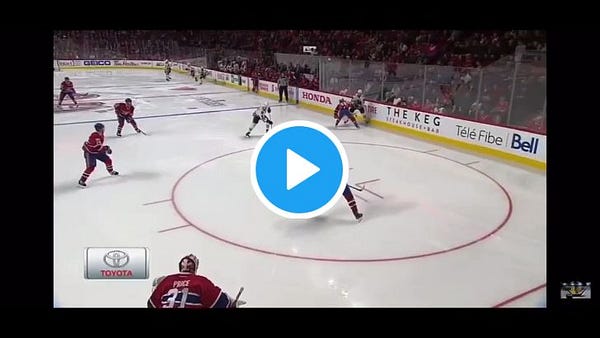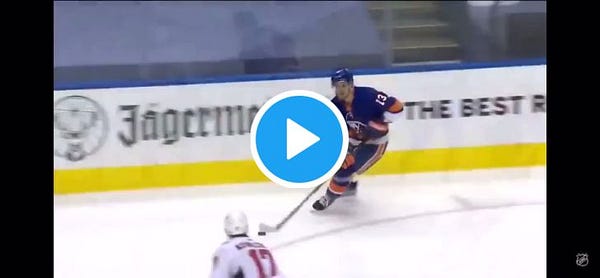Athlete Processing Speed: Slowing the perception of speed
Big rocks, processing speed, and developing the tools to influence speed perception in ice hockey
I recently sent out a tweet diving into the big rocks of player development and want to do a deeper dive on it. At the end I’ll give some actionable drills for hockey coaches.

“Speed of hand, speed of foot, speed of mind; train for each of these…but never forget, the most important is speed of mind.” - Anatoli Tarasov, the father of Russian hockey that led to their dominance in international hockey for 40 years.
As Tarasov points out… the most valuable asset in ice hockey (and in sports in general) is the speed of mind. The mind must take in information, process/analyze, and then take action. The first step is being able to take in information for processing.
There are two keys areas I want to highlight in which players take in information.
(1) Before getting the puck. Players should know what they are going to do before the puck ever touches their stick. This requires a shoulder check/pre-scan.


(2) While controlling the puck. Players should be collecting information to understand their options. Below we can see Mat Barzal’s ability to take in a ton of information. This is a large reason as to why he is able to do everything at a ridiculous speed.


One more great example from Nathan MacKinnon. Watch his head and notice the glances he takes to gather information from the ever changing situation.
Every situation has awareness needs. There is a larger than normal benefit for players that are able to increase this skill. As with all big rock skills, if a player picks this skill up they are able to translate it to other areas of their game and up the hockey pyramid.
Processing speed
A player’s processing speed is directly related to the perception of speed in their minds. Giving players the tools to slow the game down in their heads is the key to increasing their ability to process situations in games.
If they don’t have the tools or their awareness tools aren’t developed, players can become trapped by the speed of the level they play. They won’t be developing the thinking skills required to translate up the hockey pyramid.
Players that can think at or above the speed of the level in which they play are then able to make further development gains as they can think through situations and make changes as needed. Otherwise it’s just survival… a space in which players do not thrive.
This is a personal point of frustration as a coach. It pains me to see players push to play at a level in which they are not mentally prepared for. I’ve seen time and time again a stalling in a player’s trajectory because they are rushing their development.
Developing the tools
Ice awareness = Ability to perceive a situation on the rink. The ability understand what is happening or the ability to isolate and focus on the critical factors of a situation.
As players develop, ice awareness is almost always tied to their puck competence - their ability to control and manipulate the puck. While puck competence helps, this does not have to be a major limiting factor in picking up ice awareness as a skill.
The best way to influence player’s processing speed is by putting them in situations where they are forced to use ice awareness and take in information constantly.
Even beyond the obvious there are other benefits for players:
Decision making quality increases
Chance of injury decreases
Speed of decisions increases
Understanding of opportunities increases
Fewer pucks are thrown away for turnovers
Drills that increase ice awareness
Passing Chaos - 8 Lines (4 line near each boards in the neutral zone) and start with 4 pucks on one side. The players must pass and then get in the back of that line. The cannot go straight across. This gets them scanning the ice and finding the open line.
Puck Possession - In one offensive zone, throw 1 puck in for about every 2.5 players. Players play keep away. They must be aware of their surrounding and who the threats are to take their puck. It’s a great way to observe which players have the desire to win the puck back.
Wall dump awareness - Players pair off and spread out around the rink. Player 1 dumps the puck against he wall and go to retrieve the puck. Player 1 must shoulder check, turn with puck quickly, and make a tape to tape pass to Player 2. Player 2 is to move around to make it difficult on Player 1. This is also a great way to make sure players are aware of their teammate’s handedness.
The Arsenal Rush - Full ice. D start in opposite corners + forwards in opposite corners. Whistle blows and one end start with D giving cross ice pass to the F going up the wall. F goes to touch the red line and then play 1v1 vs the D. When play is disrupted the coach whistle and the same happens at the opposite end while the current end hustles to join the play (D joins to play offense and F gets back to play defense) . This is a continuous 2v2. Full breakdown and video at TheCoachesSite (Premium)
Other - Little elements can be added to drills. For example, a standard 3 line shooting warmup from the blueline can add a stop and one touch pass after shooting. The players need to know each other’s handedness and concentrate after shooting a puck.
Ice awareness is a big rock and needs built into training sessions. This isn’t hockey specific and can be taken to other sports as well. How can you increase awareness?
Check out our series diving into scanning research, advanced scanning, and training scanning
Further Reading
Did you enjoy this newsletter?
Help us spread the ideas within and share it with the people you care about


